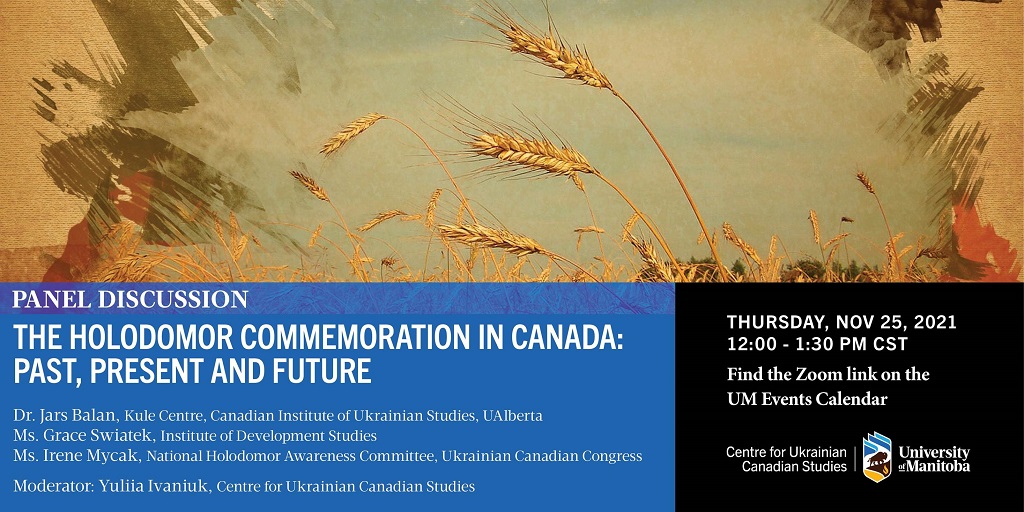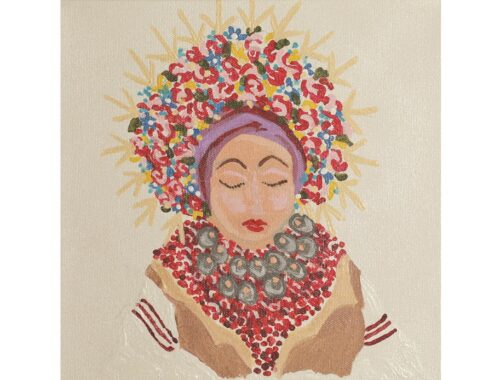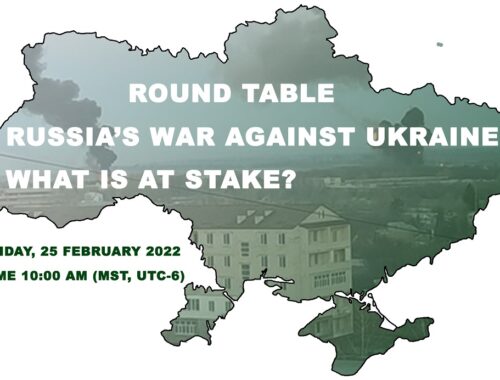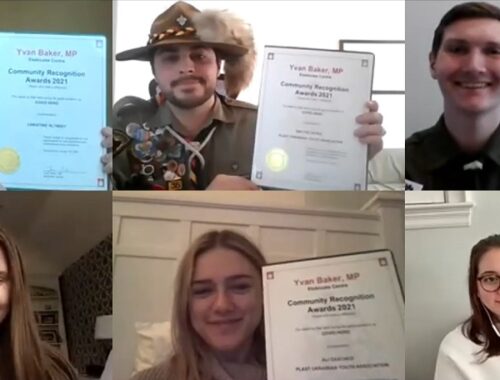
UofM panel reflects on legacy of Holodomor
On November 27, Canada’s Prime Minister Justin Trudeau marked Holodomor Memorial Day by issuing a statement, in which he joined Ukrainian communities in Canada and around the world to remember the millions of innocent victims who suffered or lost their lives during the Holodomor.
“In 1932 and 1933, the Soviet regime of Joseph Stalin orchestrated a deliberate famine – a genocide against the Ukrainian people – to impose total control over Ukraine, destroy the will of the people, and erase their identity,” the statement said. “During this horrific campaign, millions died from starvation, including children, and countless others were either deported, imprisoned, or executed.”
Trudeau’s statement went on to say that “the atrocities of the Holodomor were hidden from the world.” However, a Ukrainian scholar Jars Balan believes that this was not the case.
“There’s no excuse that people didn’t know about what was going on,” Balan said during a discussion on Holodomor, hosted by Centre for Ukrainian Canadian Studies at the University of Manitoba on November 25.
According to him, a large number of Canadians were in Soviet Ukraine in 1930-33, including eight professional journalists. Three of them would produce more than 160 articles published in the Toronto Star, The Globe and Toronto Telegram, many of which would be reprinted in the Winnipeg Free Press, The StarPhoenix in Saskatoon, the Windsor Border Cities Star, Regina Leader Post, Edmonton Journal, Edmonton Bulletin and other Canadian dailies.
“The articles were generally 1,200 to 2,000 words long and they often started on the front page,” Balan said. “So, they were widespread, very prominently featured.”
Balan listed journalists who spoke about the famine across the Canadian and the American press. Some of them included:
- Pierre van Paassen was the author of 60 articles describing two trips in 1932 and in 1933;
- Frederick Griffin, the Toronto Star journalist, wrote a total of 47 articles while he was in the Soviet Union. Of those, 37 were reprinted in the Winnipeg Free Press, 17 in the Windsor Border Cities Star. At the same time, lecturers were drawing huge crowds during talks about the famine across the country. Griffin, for example, spoke to 500 people at the Canadian Club at the Royal York Hotel in Toronto;
- Rhea Clyman, who grew up in Toronto and lived for three years in the Soviet Union, wrote 22 articles in 1932 about trips she made to Russia’s far north, where she witnessed the mass exploitation of slave labor by the Soviets in the Gulag;
- Robert Cromie, publisher and editor of the Vancouver Sun who spent nine days in Moscow and Leningrad, thought a great economic boom is happening. He was interviewed in the American press and Canadian Press. He gave a talk in Vancouver and that was published in its entirety in the Vancouver Sun.
- H. G. Bartholomew, a Toronto engineer who worked for two and a half years on a project in the Soviet Union, ended up writing 21 articles in the Toronto Telegram, characterizing the five-year plan as a failure, talking about how starvation was imminent and that the oppression was terrible.
“The point is, the famine was discussed, reported on, debated and in many cases effectively dismissed, especially in the Canadian Press,” Balan said.
The Ukrainian community had its own sources of information, like the Ukrainian Canadian Press and their connections to the Western Ukrainian press. But the communist Ukrainian press denied any famine rumors, Balan said, and tried to cover it up and deflect attention away. This was evident with hunger marches that took place in Edmonton and in different cities across Canada, which drew attention to the fact that people in Canada were hungry too.
“It’s true that depression was hard,” Balan said. “Food was in short supply. There were people who suffered some effects of malnutrition. But there was not mass starvation, like there was in Ukraine.”
Balan called the Soviet Union a “leaky sieve” in that, although the Soviet Union tried to suppress information from getting out, there was no way that they could really do it. However, he said, while the Soviets were unable to totally suppress the information, they managed to muddy the water enough to send out contradictory accounts.
“You had people writing letters to the editor saying, ‘we don’t know who to believe’”, he said. “It was a very, very muddy picture that emerged.”
The Holodomor’s history continues through monuments, said Grace Swiatek, a graduate student at the Institute of Development Studies in England.
“Behind every design of every monument, there’s a diasporic designer who’s had a big influence on commemoration,” she said during the panel.
The Broken Ring of Life monument in Edmonton was the first ever monument which was dedicated to Holodmor. At the time of its unveiling in 1983, Ukraine was both without independence and was being forced to publicly follow the Soviet Union’s denial of the manmade famine. The monument was generously sponsored by the Temerty Foundation, which was also instrumental in funding of the Holodomor Education and Research Consortium.
“I think it can be interpreted as a symbol of the scar left on humanity by the authoritarian regimes throughout the world,” she said. “It’s quite a universal symbol.”
Swiatek said that the monument encourages the viewer to feel quite uncomfortable, inspiring unfamiliar members of the public to engage with it.
“The desperate tide of mangled hands bring out quite an emotive feeling,” she said, “encouraging a feeling of empathy to Ukraine at that time in the 1980s, when they’re trying to create a new narrative, even before independence.”
It reinforces the anti-Soviet rhetoric the Ukrainians tried to put across, she said.
Swiatek said that a turning point for Western recognition of Holodomor as a real tragedy was Holodomor’s 50th anniversary, commemorated with the erection of the Holodomor monument in Winnipeg on 24 June 1984.
“I think it marks the start of a longer journey to international understanding,” Swiatek said.
The Ukrainian Canadian community continues to invest in these projects. The Bitter Memory of Childhood monument in Toronto was the most recent monument, unveiled in 2018 outside the Canadian National Exhibition, commemorating the 85th anniversary of Holodomor. The Toronto memorial’s unveiling event reflected on a lot of themes around historical identity, which Swiatek said was “nice to have”, rather than just the tragedy in the deaths themselves.
“It’s more about growth and recognition and fixing the past injustices which have been put upon the Ukrainian people,” she said. “I think the Toronto memorial is a huge milestone to see how far commemoration had come over that 40-year gap between the first one in Edmonton and see how much has been achieved in Canada.”
However, there is still a lot more work to be done, said Irene Mycak, Chair of the Ukrainian Canadian Congress (UCC) National Holodomor Awareness Committee, with recognition being a big effort on the part of the international community.
“In Canada, we can be very proud of our federal legislation and legislation in six provinces,” she said. “We are currently working with the Ukrainian community in Halifax toward official recognition by the province of Nova Scotia. And we hope that soon after, the remaining Atlantic provinces will also follow.”
Mycak told the panelists that internationally, 17 countries have passed legislation recognizing the Holodomor. There have been countless resolution statements by governments and international institutions. Additionally, nationwide provincial recognition needs to be accomplished in Canada, along with nationwide inclusion in school curriculum.
“We look forward to building a very strong descendants network, which will be the future of this issue going forward,” she said. “And most importantly, we need to broaden the conversation. We need to bring other groups into this conversation, be it the Indigenous peoples, Jews, Armenians, Rwandans, all peoples who have suffered similar atrocities.”
“I have to admit that this is an uphill battle,” she said. “But it’s a battle that we’re not leaving. And the international Ukrainian community will not rest until we have achieved recognition in every country of the world, and the United Nations as well.”
The Prime Minister’s statement on November 27 commended the resilience of Ukrainian people in the face of hardship, saying that “The resilience of the Ukrainian people and the survival of their culture, language, and identity is a testament to their courage and strength.”
“Today, it falls to each and every one of us to ensure this dark chapter in history is not forgotten, and to continue to defend human rights and democracy when they come under threat,” the Prime Minister’s statement said.
This article is written under the Local Journalism Initiative agreement
Kateryna Bandura for New Pathway – Ukrainian News
Follow me on social media!You May Also Like

Ukrainian art community launches an anonymous online auction
October 30, 2021
Russia’s open war against Ukraine can help nation-building: expert
March 1, 2022

